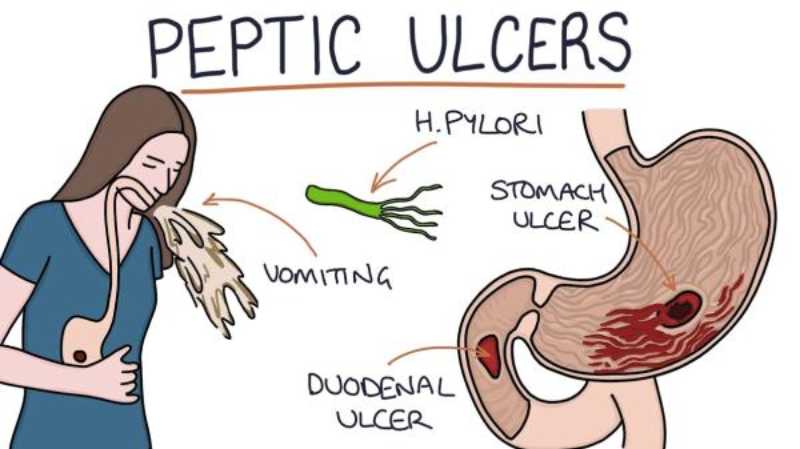Natural Diet for Gastric and Duodenal Ulcer
Table of Contents
Symptoms of Gastric and Duodenal Ulcer
- Indigestion and constipation
- Aversion to food
- Nausea after meals
- Pain in the stomach immediately or 1-2 hours after eating

Causes of Gastric and Duodenal Ulcer
Partially-digested food passes from the stomach into the duodenum or upper intestine for further assimilation. There, digestion is done by the digestive fluids with the help of:
- bile from the liver
- digestive juices from the pancreas
But if those 2 are defective, the food is not completely digested. It becomes spoiled and vitiated.
At the same time, the unassimilated digestive fluids and bile also become spoiled and create an adverse reaction in the system.
This spoiled digestive fluid and bile is the cause of gastric and duodenal ulcers.
Blood circulation in the walls of the stomach and duodenum is slowed down by habitually undertaking mental or physical exertion after a meal without having any rest.
This makes the membrane lining of the organs easily susceptible to the acidic poison. This causes the ulcer to appear.
Ideally, the alkaline secretions in the body should maintain a balance with the acids. But this can fail when:
- the acid-secreting organs have to remain constantly active in order to digest non-vegetarian foods, or
- the alkaline secreting glands become weak from constipation, dyspepsia or any other disease
These extremely poisonous acidic fluids then go on unimpeded.
Wherever this excess acidic fluid accumulates, an ulcer forms gradually as wounds in:
- the stomach as gastric ulcers
- the duodenum as duodenal ulcers
- etc
The blood becomes weak due to:
- excessive mental exertion coupled with a lack of physical labour
- the use of very strong medicines and injections
- an unrestrained life
Weak blood makes the membrane of the duodenum weak and unable to fight the accumulated acidity, letting it become ulcerated.
If the ulcer is in the stomach, the patient suffers pain immediately after eating.
But if that ulcer forms inside the duodenum, the pain starts after a short time.
- In this case, the pain originates to the right of the navel.
With gastric ulcers, the consumed food has less opportunity inside the body to be digested. This makes the patient thin and worn out.
With duodenal ulcers, the change takes a long time to show externally.
Blood oozing out of the ulcer wound tries to find an outlet. It is emitted through vomiting, or through the anus or the urinary passage.
That is why the patient feels nauseated when suffering from acute stomach or duodenal ulcers. After vomiting, he always gets some relief.
Often, slightly darkish blood comes out with the vomiting (haematemesis).
In a severe state of the disease, the stool of the patient also appears blackish.
Even when the disease is not in the severe state, the stool comes out in pellets and a darkish colour.
This disease generally attacks people in early youth and kills them at the end of youth or in middle age.
Diet for Gastric and Duodenal Ulcer
In the severe state of the disease, only plenty of water and sweet or sour fruit juice should be taken.
When blood is vomited, the patient should be fed durbá juice [durva grass] or kuksiimá-leaf extracts only.
When the patient is a little better, he or she should be given a small quantity of diluted milk with honey to drink.
As long as the stool remains dark, the patient should be given only:
- different kinds of fruit juice, sweet or sour
- the filtered juice of ripe tomatoes
- miśt́i nebu juice
- well-boiled potatoes thoroughly mashed with diluted milk.
After the severe state of the disease has passed, the patient may eat soup or stew made out of potatoes, pat́ol, jhiḿge, dhundula or similar easily-digestible vegetables, along with boiled old rice (grains a few years old), etc.
In this state, a small amount of pure, warm ghee should be taken with rice or fresh rut́i.
As long as even a vestige of the disease persists the patient should never eat much at a time.
Instead, food should be eaten several times a day, eating only a small quantity each time.
The cure of this disease depends largely on the selection of diet – therefore, even after getting well, the patient should observe the dietary provisions strictly for a couple of years.
Dos and don’ts for Gastric and Duodenal Ulcer
Acidity is the main cause of this disease, so it is desirable that food which can increase acidity be carefully avoided.
An ulcer patient must give up:
- non-vegetarian food
- all types of intoxicants
Food which would stimulate or irritate the stomach should also be forsaken.
Extra-sweet, hot (spicy) and salty foods are unwholesome for an ulcer patient.
Once the patient gets well, he or she will find alkaline food best.
But it is better not to take fibrous food even after a complete cure.
After normal health has been restored, the patient should include in the diet:
- spinach
- beto shák
- mat́ar shák
- jute leaves
This is to help clear the bowels and to prevent the vomiting of blood.
As a medicine, shushuni shák fried in ghee is also excellent.
All ulcer patients must take daily at least 2-3 spoonfuls of honey mixed with water or milk.
Habitually doing physical or mental work without taking rest after meals is most harmful.